Campus Water Quality

Learn how water is conserved and monitored at UC San Diego.
Environment, Health & Safety (EH&S) helps with conservation efforts and maintaining water quality across campus.
Drinking water
Drinking water on UC San Diego's campus is provided by the City of San Diego Public Utility.
Water Quality Reports
The City of San Diego publishes an annual Water Quality Report (also known as the Consumer Confidence Report) for the water it provides. This state-mandated report includes details about where our water comes from, what it contains, and how it compares to state standards.
- See Water Quality Reports for the City of San Diego
Campus water quality
Water quality present in campus buildings should be the same or better than that provided by the City of San Diego.
UC San Diego's Environment, Health & Safety (EH&S) department can and does respond directly to concerns about campus water quality. Upon request, EH&S will inspect facility water lines to ensure cross connections have not been made, and that backflow prevention devices are correctly installed and maintained. EH&S does not provide free water testing analysis, but will consult on having the tests done.
- Contact Environment, Health & Safety, (858) 534-5242 or 534-7513
New and repaired water lines
EH&S oversees disinfection of newly installed or repaired potable water lines to ensure harmful bacteria are not introduced to the water after it arrives on campus. Escherichia coli, total coliforms, and heterotrophic bacteria are tested to ensure they do not exceed Environmental Protection Agency standards.
EH&S, Facilities Management, and Facilities Design & Construction must be contacted and approval obtained before operational or construction modifications are made to any UC San Diego water facilities. See FD&C Master Specification 15141 Disinfection of Potable Water Lines for details.
Further resources
- Information regarding the boil water order (restaurants and bars), County of San Diego, CA – During emergencies
- PPM 516-10-6 Environmental Sanitation Water and Sewage
Recycled water
 UC San Diego utilizes recycled water for both landscape irrigation and cooling tower water throughout the campus. Recycled water reduces campus potable/drinking water usage, saves the campus money and helps to lower the overall demand
UC San Diego utilizes recycled water for both landscape irrigation and cooling tower water throughout the campus. Recycled water reduces campus potable/drinking water usage, saves the campus money and helps to lower the overall demand
UC San Diego receives tertiary 2.2 recycled water from the City of San Diego Miramar treatment facility. Recycled water is regulated by both California Title 17 and Title 22. EH&S partners with the County and City of San Diego to comply with these regulations. Cross-connection tests are conducted at each UC San Diego site every 4 years. Testing, using pressure differentials, ensures that drinking water lines and recycled water lines are not connected and the public is not consuming recycled water.
Recycled water use sites at UC San Diego can be found by referring to the map below. Purple recycled water signs are also located around the campus.
Further resources
- Recycled Water Shut Down Dates and Contacts
- Recycled Water Testing Checklist for UC San Diego
- Recycled Water Sign Design Requirement
- UC San Diego water conservation efforts
- San Diego County Department of Environmental Health
- Health and Safety Code, Water Code, and Titles 22 and 17 of the California Code of Regulations – From the California Water Boards
- Recycled Water Study – From the California Sustainability Alliance
- Water Recycling and Reuse: The Environmental Benefits – From The US Environmental Protection Agency
- PPM 516-10-6 Environmental Sanitation Water and Sewage
Swimming pools & spas
Environment, Health & Safety (EH&S) staff regularly inspect all swimming pools and spas on UC San Diego property to safeguard against injuries and the spread of waterborne diseases. Water quality, recirculation equipment, and safety features are evaluated during each inspection.
The County of San Diego Environmental Health Department does not inspect these facilities since EH&S has authority to do so.
Department responsibility
It is the responsibility of the department operating the pool or spa to maintain the facility in compliance with all pertinent California Health & Safety Code, Building Code, and Code of Regulation Standards.
EH&S must be consulted and approval obtained before any operational or construction modifications are made to UC San Diego pools and spas.
Further resources
- PPM 516-10.5 Environmental Sanitation Swimming Pools
- PPM 516-10-6 Environmental Sanitation Water and Sewage
Water conservation

Sustainability is an integral part of education, research, and campus operations. Because of the recent severe droughts, UC San Diego is taking even greater action to reduce water consumption.
The plan focuses on a variety of conservation measures and details how we are working toward the University of California goal to reduce campus-wide potable water use by 20 percent from our baseline by 2020. Under the plan, we have: UC San Diego already saves millions of gallons of water annually through implementation of a comprehensive Water Action Plan (PDF).
- Retrofitted existing irrigation systems with low-flow devices, resulting in an annual savings of 7.2 million gallons of irrigation water used.
- Included water-saving features in the design of new buildings that will save approximately 1.5 million gallons per year.
- Installed computer-controlled irrigation systems that have the potential to save more than 100 million gallons of water annually.
- Utilized fire hydrant testing water at the Central Utilities Plan for the cooling towers, resulting in saving approximately 300,000 gallons per year.
- Installed laminar water flow devices in nearly 1,000 faucets at the Hillcrest Medical Center, saving approximately 2 million gallons annually.
- Installed low-flow water fixtures and native or drought tolerant vegetation in all new construction and installed low-flow water fixtures in the majority of existing campus residential facilities. All design guidelines and neighborhood plans specify low water sustainable landscape practices.
Learn more about how UC San Diego resources are committed to additional drought response measures.